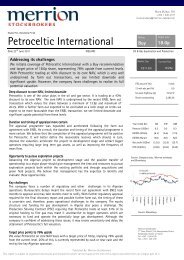Quarterly Bulletin Q3 2013
Quarterly Bulletin Q3 2013
Quarterly Bulletin Q3 2013
You also want an ePaper? Increase the reach of your titles
YUMPU automatically turns print PDFs into web optimized ePapers that Google loves.
The Domestic Economy<br />
<strong>Quarterly</strong> <strong>Bulletin</strong> 03 / July 13<br />
23<br />
Table 7: Inflation Measures – Annual Averages, Per Cent<br />
Measure HICP HICP Services a Goods a CPI<br />
excluding<br />
Energy<br />
2010 -1.6 -2.7 -0.7 -2.4 -1.0<br />
2011 1.1 0.0 0.8 1.5 2.6<br />
2012 2.0 0.9 1.9 2.0 1.7<br />
<strong>2013</strong> f 0.8 0.9 1.6 0.0 0.9<br />
2014 f 1.1 1.4 1.7 0.4 1.0<br />
a<br />
Goods and services inflation refers to the HICP goods and services components.<br />
economy-wide earnings have been broadly<br />
stable since 2008. Private sector hourly pay<br />
has been flat since 2009 and increased in Q1<br />
<strong>2013</strong>. Public sector hourly earnings declined<br />
by 3.7 per cent in 2010 (excluding the impact<br />
of the pension levy), but registered marginal<br />
increases in both 2011 and 2012.<br />
Turning to the outturn for Q1 <strong>2013</strong>, although<br />
overall economy-wide weekly earnings were flat<br />
in the first quarter, this masks differences in wage<br />
movements in the public and private sector.<br />
Hourly pay rose by 1.5 per cent in the private<br />
sector while hours worked declined by 1 per<br />
cent. In the public sector, both hourly earnings<br />
and hours worked declined by 0.5 per cent.<br />
At a sectoral level, average hourly earnings<br />
rose in six of the thirteen economic sectors<br />
annually in the first quarter of <strong>2013</strong>, with the<br />
largest percentage increases recorded in the<br />
administrative and support services sector and<br />
transportation and storage. The largest annual<br />
decline in hourly earnings was recorded in the<br />
professional, scientific and technical sector.<br />
Overall average hourly earnings in Q1 <strong>2013</strong><br />
remained 0.6 per cent below their level recorded<br />
four years earlier.<br />
Looking ahead, pay pressures in the economy<br />
are expected to remain muted over the<br />
period of the forecast. The unemployment<br />
rate is projected to stay above 13 per cent<br />
and domestic demand is set to recover only<br />
gradually. Meanwhile, in the context of the ongoing<br />
efforts to reduce the budget deficit, there<br />
is unlikely to be significant upward movement<br />
in public sector pay. Overall economy-wide<br />
compensation per employee is expected to<br />
remain close to or below the rate of inflation<br />
over the forecast horizon. Annual growth in<br />
economy-wide compensation per employee<br />
should average 1.5 per cent in <strong>2013</strong> and 1.2<br />
per cent in 2014. Improved labour market<br />
conditions should support marginally stronger<br />
wage growth in the private sector next year.<br />
Inflation<br />
In 2012, the annual rate of inflation in Ireland as<br />
measured by the HICP averaged 2 per cent.<br />
The energy component was the main driver<br />
of inflation, as it contributed to 1.1 per cent<br />
of the overall HICP inflation rate. In absolute<br />
terms, the HICP energy component increased<br />
by 9.4 per cent in 2012, as the increase in<br />
oil prices in dollar terms was reinforced by<br />
the weakening of the euro vis-à-vis the US<br />
dollar. For the year to date, oil prices in euro<br />
terms have decreased and are not expected<br />
to increase in the coming months given the<br />
weak economic environment. As a result, the<br />
contribution of imported energy price inflation<br />
in <strong>2013</strong> is expected to be marginal. These<br />
aforementioned factors are also driving down<br />
HICP goods inflation, which is expected to be<br />
flat this year and average 0.4 per cent in 2014.<br />
Services inflation, which represents a<br />
reasonable proxy for domestically generated<br />
inflation, should remain fairly stable relative to<br />
last year reflecting weak domestic demand. It<br />
is anticipated to average 1.6 per cent in <strong>2013</strong><br />
and 1.7 per cent in 2014.<br />
These factors have motivated a downward<br />
revision to the inflation forecast, with HICP




